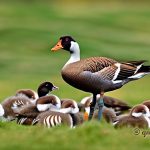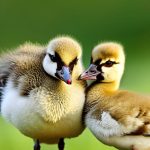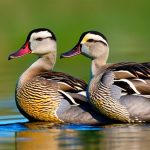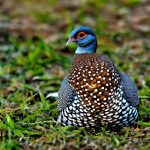If you’re tending to a brood of nesting geese, there’s something truly special about the quiet moments spent wondering if those oversized treasures are cozy enough. You find yourself enveloped in a gentle kind of excitement mixed with a dash of worry—do they have everything they need? When it comes to goose eggs, each one is more than just a promise of new life; it’s like waiting for your own feathery family to grow.
I know that feeling well—the daily visits to my feathered charges, the careful checks on the nest temperature and humidity, all while crossing fingers for a successful hatching outcome.
My journey through heaps of research and hands-on trials has revealed that though 30 days might be the incubation norm, it’s not always so cut-and-dried. In this blog post, I’m thrilled to walk you through top-notch incubating practices and what comes after those goslings peck their way out into the world.
By sticking with me here, you’ll snag essential insights that could very well earn you bragging rights as an ace in goose stewardship within your community! So let’s dig in—we’ve got quite the adventure ahead!
Incubation and Hatching of Goose Eggs
When it comes to incubating and hatching goose eggs, there are reliable methods for both natural and artificial incubation. It’s important to have the necessary equipment and understand the factors that can affect the incubation time.
Reliable methods
I always trust two main ways to hatch goose eggs: natural and artificial incubation. With natural incubation, a broody goose does all the work. She keeps the eggs warm and turns them as needed.
For this method, I make sure she has a comfortable nest in a quiet spot.
For artificial incubation, using an incubator is key. I keep an eye on the temperature and humidity levels every day. They need to be just right for the eggs to develop properly. Eggs should stay at about 99.5 degrees Fahrenheit with around 55% humidity.
Turning the eggs regularly is important too; it stops them from sticking to the shell.
Both methods have their pros and cons but being careful with these details can lead to successful hatching!
Natural vs artificial incubation
Natural incubation involves a broody goose sitting on her eggs to keep them warm, while artificial incubation requires the use of an incubator. The average goose egg takes around 28 to 35 days to hatch naturally, but with artificial incubation, this process can be more controlled and may lead to higher hatch rates.
Temperature and humidity are crucial factors for both methods, affecting the success of hatching goose eggs. While natural incubation relies on the mother’s instincts, artificial incubation allows for precise monitoring and adjustment of these conditions.
The choice between natural and artificial incubation depends on various factors such as available resources, space, and experience. Though natural brooding is instinctual for geese and requires minimal human intervention once started, it is important to consider potential risks from predators or other disruptions during this period.
Necessary equipment
To successfully incubate goose eggs, you will need the following necessary equipment:
- Incubator: A reliable and adjustable incubator is crucial to maintain consistent temperature and humidity levels throughout the incubation period. It should have automatic turning capabilities for even heat distribution.
- Thermometer and Hygrometer: Accurate digital thermometer and hygrometer are essential for monitoring the temperature and humidity levels within the incubator, ensuring optimal conditions for egg development.
- Candler: A candler is used to inspect the interior of the eggs during incubation, allowing you to check for signs of embryo growth and detect any potential issues.
- Egg Turner: An automatic egg turner takes the manual work out of rotating the eggs, mimicking a brooding bird’s natural movement to prevent embryos from sticking to the shell membrane.
- Sanitizing Supplies: Keep a supply of disinfectants on hand to maintain cleanliness in both the incubator and surrounding area, reducing the risk of contamination.
- Backup Power Source: Consider having a backup power source such as a generator or battery backup in case of unexpected power outages to ensure stable incubation conditions.
- Data Recording Tools: Keep a notebook or digital device handy to record important data such as temperature, humidity levels, egg turning schedules, and observations throughout the entire process.
Factors Affecting Incubation Time
Egg collection and storage, temperature, humidity, as well as cooling and misting are crucial factors that can affect the incubation time of goose eggs. Understanding how these variables impact the development of your goslings is essential for a successful hatching process.
Egg collection and storage
When collecting goose eggs, handle them gently to avoid damaging the delicate shells. Store the eggs in a cool place around 55°F and with a humidity level of 75-80%. Turn the eggs once daily to prevent the embryo from sticking to the shell.
Maintain clean egg storage conditions as dirty or cracked eggs can compromise hatchability. Avoid washing goose eggs before storage, as this removes their protective cuticle and increases the risk of contamination.
Always label egg cartons with collection dates for proper rotation and ensure that older eggs are used first for incubation.
Temperature
Maintaining the right temperature is crucial during the incubation period. Goose eggs require a consistent temperature of around 99-100°F (37-38°C) for successful development. Fluctuations in temperature can negatively impact the hatching process, so it’s essential to use a reliable thermometer and adjust the incubator as needed.
Proper heat distribution within the incubator is vital to ensure all eggs receive uniform warmth. Preventing sudden exposure to cold temperatures is essential as even brief fluctuations can harm developing embryos.
Keeping a stable environment will increase the chances of healthy goslings hatching at the end of the incubation period. These measures greatly contribute to successful hatching outcomes and healthy goslings.
Humidity
Maintaining the appropriate humidity level is crucial during the incubation of goose eggs. By simulating the natural moisture conditions, we can help ensure successful hatching. The ideal humidity for goose egg incubation generally ranges between 45% to 55%, essential for healthy embryonic development and preventing dehydration.
Monitoring and adjusting humidity levels accordingly are vital factors in achieving a favorable hatching outcome.
To prevent any complications during the incubation period, consistent monitoring of temperature and humidity levels should be maintained regularly. This balanced attention to both factors significantly contributes to a higher success rate in hatching goose eggs, promoting optimal conditions for gosling development.
Cooling and misting
After ensuring the right humidity levels, it’s crucial to address cooling and misting during the incubation period for goose eggs.
- Regular but brief periods of cooling can be beneficial for the embryos as it simulates natural conditions.
- Misting the eggs occasionally helps maintain the necessary moisture levels for healthy development.
- Avoid prolonged exposure during cooling, as extreme temperature fluctuations can harm the developing goslings.
- Use a gentle mist to lightly dampen the eggs, mimicking natural nest conditions without causing excessive wetness.
- Ensure that the cooling and misting processes are carried out with care and attention to detail throughout the incubation period.
Tricks and Tips for Successful Hatching
– Candling eggs can help you monitor the development of the embryos inside, while using a broody goose can be an effective and natural way to hatch your goose eggs.
Candling eggs
Candling eggs is a vital practice during the incubation period to assess the development of the embryos and ensure their viability.
- Use a bright light source such as a flashlight or a specific candling device to gently shine through each egg.
- Check for signs of fertility, such as visible veins or a red blood ring, which indicate healthy embryo development.
- Look for clear indications of infertility, like blood spots or a lack of any internal structures, in which case the egg should be removed from the incubator.
- Monitor the air cell size, as it should increase as incubation progresses; this can provide insights into humidity levels and egg ventilation.
- Avoid excessive handling of the eggs during candling to minimize potential damage and maintain optimal conditions for successful hatching.
- Keep accurate records of your observations after each candling session to track the progress and make informed decisions throughout the incubation process.
Using a broody goose
When considering hatching goose eggs, utilizing a broody goose can be an effective and natural method. Broody geese are known for their strong maternal instincts, making them excellent candidates for incubating and hatching eggs.
Their dedication to keeping the eggs warm and protected helps ensure a higher hatch rate. Additionally, the use of a broody goose reduces the need for artificial heating equipment and constant monitoring, providing a more hands-off approach to egg incubation.
Geese keepers should consider placing fertilized eggs under a broody goose when seeking a more natural incubation process. This method aligns with the geese’s instinctual behaviors and can lead to successful hatching without extensive human intervention or specialized equipment.
Weight loss calculation
Calculating weight loss during incubation is crucial for successful hatching. Here are the key steps to ensure accurate weight loss calculation:
- Weigh the eggs at the beginning of incubation.
- Record the initial weight for each egg.
- Regularly weigh the eggs throughout the incubation period, approximately once a week.
- Calculate and track the percentage of weight loss for each egg.
- Ideally, goose eggs should lose about 11 – 13% of their original weight by the time they are ready to hatch.
- Adjust humidity levels if necessary to achieve optimal weight loss.
After Hatching
Caring for newborn goslings can be challenging, but with the right knowledge and resources, it can be a rewarding experience. Raising geese requires patience and proper care to ensure their healthy development.
Caring for newborn goslings
When caring for newborn goslings, it’s essential to create a warm and cozy brooding area to keep them safe from predators and harsh weather.
- Provide a cozy, clean, and draft – free brooder with the right bedding material to keep the goslings warm and dry.
- Ensure they have access to fresh water at all times, using shallow dishes or special waterers designed for young birds.
- Offer a high – quality starter feed specifically formulated for goslings to support their rapid growth and development.
- Monitor the temperature in the brooder, keeping it around 90 – 95°F initially and gradually lowering it as the goslings grow.
- Handle the goslings gently to help them become accustomed to human interaction, which is important if you plan to raise them as friendly geese.
Raising geese
Raising geese involves providing a safe and comfortable environment for goslings to grow. Ensure proper shelter, clean water, and appropriate feed for optimal growth.
The behavior and biology of geese play crucial roles in their development. Understanding their needs helps create an ideal habitat for the growing goslings.
Recommended resources
For reliable information on the ideal temperature and humidity levels for goose egg incubation, refer to reputable poultry farming guides and avian development resources. Understanding the mating behavior and nesting habits of geese can be found in wildlife conservation materials and bird reproduction studies.
Additionally, trusted animal reproduction literature can provide valuable insights into caring for newborn goslings and raising geese successfully. Ensure a clean nest by consulting poultry farming references for best practices in maintaining comfortable conditions during incubation.
Utilize waterfowl breeding guides to troubleshoot common issues that may arise during the incubation period of goose eggs. These resources often offer practical tips on candling eggs and calculating weight loss for successful hatching.
Troubleshooting common issues
After hatching, it’s crucial to be aware of potential problems that may arise. Here are some common issues you might encounter and how to address them:
- Egg pipping without progress: If a gosling starts pipping but seems to make no progress, the humidity might be too low. Increase humidity slightly and monitor.
- Weak or inactive goslings: Check if the temperature is suitable; weak or inactive goslings could indicate that it’s too cold. Adjust as needed and observe changes.
- Rough handling by adult geese: Separate aggressive or overly curious adult geese from the goslings to prevent injuries and stress.
- Unhealthy diet affecting growth: Ensure that goslings have access to proper nutrition and clean water, addressing any signs of malnourishment promptly.
- Inadequate nesting environment: Maintain a comfortable and clean nesting area for successful incubation and hatching, preventing potential health issues for the geese.
Conclusion
In conclusion, understanding the incubation period for goose eggs is crucial in successfully hatching healthy goslings. By monitoring temperature and humidity levels, you can ensure a practical and efficient incubation process.
Implementing these strategies can lead to significant improvements in hatching success rates and overall geese breeding. For further guidance on this topic, explore recommended resources that offer additional insights into goose egg incubation.
Let’s take action today to apply these proven methods and witness the rewarding experience of hatching goose eggs!
FAQs
1. How long is the incubation period for goose eggs?
The incubation period for goose eggs typically lasts from 28 to 30 days.
2. What temperature and humidity are needed to hatch goose eggs?
You need an incubation temperature of about 99.5 degrees Fahrenheit and around 50% humidity, which goes up in the last few days.
3. Can a broody goose hatch her own eggs without an incubator?
Yes, a broody goose can naturally hatch her eggs, by covering them under her feathers and keeping them warm.
4. What should I know about mating geese before trying to hatch their eggs?
Before hatching, know that mating geese need a safe place to lay their eggs where they can demonstrate nesting behavior.
5. Is it important for goose egg weight to change during incubation?
Yes, ideal weight loss through evaporation is part of healthy development; it’s usually around 14% of the egg’s initial weight by hatching time.
Meet Walter, the feathered-friend fanatic of Florida! Nestled in the sunshine state, Walter struts through life with his feathered companions, clucking his way to happiness. With a coop that’s fancier than a five-star hotel, he’s the Don Juan of the chicken world. When he’s not teaching his hens to do the cha-cha, you’ll find him in a heated debate with his prized rooster, Sir Clucks-a-Lot. Walter’s poultry passion is no yolk; he’s the sunny-side-up guy you never knew you needed in your flock of friends!







